|
For education orders please call 1-877-290-8256.
Welcome again to our monthly newsletter with features on exciting celestial events, product reviews, tips & tricks, and a monthly sky calendar. We hope you enjoy it!

Follow Venus near the Sun
Venus is currently a prime observing target. It was at its greatest brilliancy on September 23, and is now moving swiftly towards inferior conjunction on October 28.
Because Venus’ orbit is closer to the sun that Earth’s, it passes between Earth and sun once every orbit. This is known as inferior conjunction to distinguish it from when Venus passes on the far side of the sun, known as superior conjunction.
Because Venus’ orbit is not in exactly the same plane as that of Earth, it usually passes above or below the sun at inferior conjunction. This year it will be passing below the sun. In addition, at this time of year the plane of the ecliptic is almost parallel to the horizon at sunset. As a result, Venus will be very low in the western sky at sunset, and hence very hard to observe.
The trick for observing Venus under these conditions is not to wait until sunset, but to observe Venus while the sun is still above the horizon.
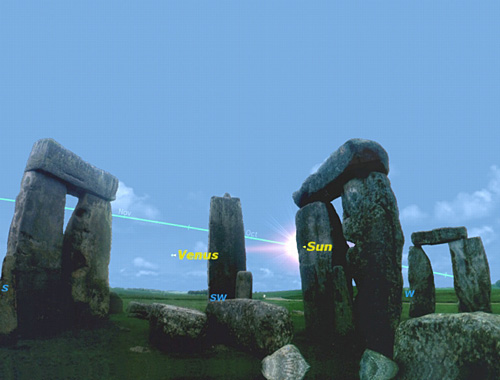
WARNING: Observing close to the sun is very dangerous! This is something only very experienced observers should attempt, and they should take careful precautions to avoid viewing the sun directly.
The trick to use is to position yourself so that the sun is safely behind a nearby building or other obstruction, so that there is no way that you can see the sun itself from your location. In the accompanying graphic, we’ve used one of the stones at Stonehenge to block the sun; you can probably do the same with a less glamorous chimney or tower.
If observing with naked eye, you may find sweeping with binoculars necessary to initially locate Venus. Use a planetarium program to determine the direction and distance of Venus relative to the sun.
A better technique is to use a telescope equipped with either accurate setting circles or a GoTo computer. Once located, Venus is readily visible in a clear blue daylight sky.
On October 6, Venus appears like a miniature crescent moon 14% illuminated. It is 49 arc seconds in diameter, large enough that its crescent can be seen in 10x binoculars. It is slightly more than 30 degrees away from the sun, and quite safe to observe.
Over the next few weeks Venus moves south and west so that it is directly under the sun on October 28, only 1% illuminated and a full arc minute in diameter. Only 6 degrees separate Venus from the Sun. Since this is less than the width of a binocular field, it is unsafe to attempt to observe Venus this close to conjunction.
The question remains, how close to conjunction can you observe Venus safely? On October 20, Venus will be 15 degrees away from the sun, probably as close as even the most experienced and careful observer would want to get. Don’t risk your eyesight by trying to observe Venus any closer to the sun than this. Instead, wait until the next inferior conjunction of Venus on 2012 June 5, when Venus will actually pass in front of the sun, and can easily and safely be observed with a standard solar filter.
Geoff Gaherty
Geoff has been a life-long telescope addict, and is active in many areas of visual observation; he is a moderator of the Yahoo "Talking Telescopes" group.
[Top of Page]

Did you see the Super Harvest Moon on September 22? Traditionally, the Full Moon nearest the fall equinox is called the Harvest Moon. This year, the equinox occurred only a few hours after moonrise in eastern North America making it a Super Harvest Moon.
Unfortunately, this caused some people to think that the Moon was bigger and brighter than ever before. As a matter of fact, the apparent size of the Moon was smaller than average. The images below allow you to compare the size of the Moon on September 22 with its size on January 1 of this year.
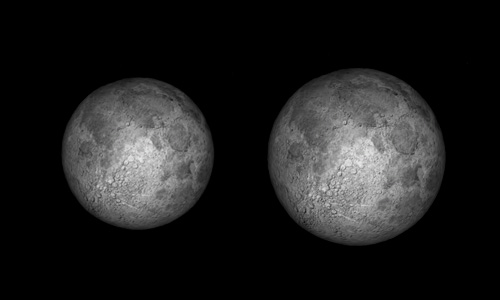
Moon's apparent size at September 22 (left) and January 1 (right).
This difference in apparent size of the Moon is caused by its orbital eccentricity.
Although the scale of the diagram below is too small to show it, the moon's orbit is an ellipse with an eccentricity of about 0.05. This causes the distance of the Moon to vary from about 364,000 km at its closest point to the Earth (called perigee) to about 407,000 km at its furthest point (or apogee).
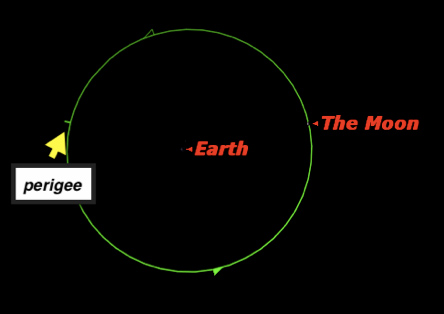
September 22
As the graphic above shows, on September 22, 2010, the moon was nowhere near perigee and hence was not at its largest apparent size.
Contrast this with the Moon's location on January 1, 2010 (see below) and it can be seen clearly that the Moon's apparent size should have been larger since it was close to perigee.
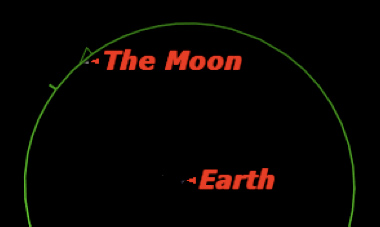
January 1
Further Study
The Moon should appear larger at perigee because it's closer to us. How often does the Moon pass through perigee and are there any other noticeable effects on Earth? Check the next Starry Night Times for the answer.
Answers to Last Month's Question
a) The Sun is in the constellation Sagittarius on Dec 21, 2010.
b) If we assume the Great Pyramid was built around 2560 BC, then the brightest star near the North Celestial Pole was Thuban in the constellation Draco.
Herb Koeller
[Top of Page]

Autumn Equinox
Advance time Advance time using the "step time forward" button. When the Sun crosses the celestial equator, autumn begins in the northern hemisphere.
Pedro Braganca
Education & Content Director
Starry Night® Education
[Top of Page]

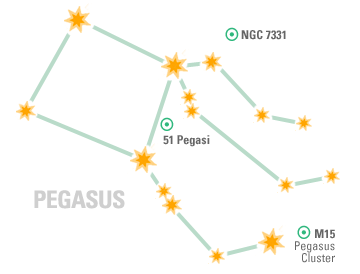
M15 is one of the most densely packed globular clusters in our galaxy, with a high number of variable stars and pulsars. Viewable with the naked eye from dark sites, binoculars and small scopes will bring out some detail of the collapsed, superdense core. M15 is also one of only a handful of globular clusters known to contain a planetary nebula.
NGC 7331, a Type 2 Seyfert galaxy about 43 million light-years away, shows a superb spiral structure.
51 Pegasi is an unexceptional 8th Mag star, but it's notable because it is orbited by the first true extrasolar planet to have been discovered.
Sean O'Dwyer
Starry Night® Times Editor
[Top of Page]
|
 |
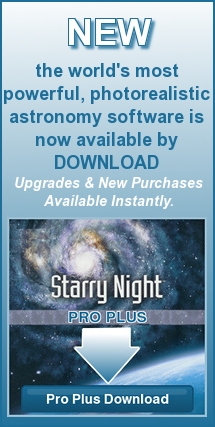 |
 |
 |
 |
 |
 |
The Layered Earth Videos

We’ve got a YouTube channel to showcase our new curriculum The Layered Earth. The Layered Earth is interactive geology and earth science curriculum for the middle school and high school classroom. A College version will be coming soon.
|
 |
 |
Pedro Braganca
Education & Content Director
Starry Night® Education
|
 |
 |
 |
 |
 |
 |
 |
Log Entries
Starry Night Pro, Pro Plus, High School and College allow you to add log notes to celestial objects.
To quickly see which objects have log entries associated with them, choose View->Show Log Markers from the main menu.
In the sky window, a red arrow will appear under a celestial object to indicate it has a log entry.
Pedro Braganca
Education & Content Director
Starry Night® Education
|
 |
 |
 |
 |
 |
 |
 |
Follow us at
• twitter.com/starrynightedu
|
 |
 |
 |
 |
 |
 |
 |
Moon Phases
 Thu., October 7 Thu., October 7
New Moon, 2:44 p.m.
The Moon is not visible on the date of New Moon because it is too close to the Sun, but can be seen low in the east as a narrow crescent the morning before, just before sunrise. It is still too low to be seen the evening after New Moon, but is visible in the southeast the next evening.
 Thu., October 14 Thu., October 14
First Quarter Moon, 5:27 p.m.
The First Quarter Moon rises around 3 p.m., and sets around midnight.
 Fri., October 22 Fri., October 22
Full Moon, 9:36 p.m.
The Full Moon of October is usually known as the Hunterís Moon. Other names are Travel Moon, Dying Grass Moon, and Blood Moon. In Hindi it is known as Kojagiri or Sharad Purnima, Lakshmi Puja. Its Sinhala (Buddhist) name is Vap Poya. The Full Moon rises around sunset and sets around sunrise, the only night in the month when the Moon is in the sky all night long. The rest of the month, the Moon spends at least some time in the daytime sky.
 Sat., October 30 Sat., October 30
Last Quarter Moon, 8:46 a.m.
The Last or Third Quarter Moon rises around midnight and sets around 2 p.m. It is most easily seen just after sunrise in the southern sky.
Observing Highlights
Sat., October 9, sunset
Venus close to the Moon
This will be a challenging observation for observers in the Northern Hemisphere, because the Moon and Venus are both very close to the southwestern horizon at sunset.
Sat., October 23, 9:41 p.m.–11:04 p.m.
Double shadow transit on Jupiter
The shadows of Ganymede and Europa follow each other across the face of Jupiter. 90mm telescope required.
Sun., October 24, all night
The Moon close to the Pleiades
The Moon, just past Full, will be close to the Pleiades, the brightest star cluster in the sky, all night long. This will be particularly pretty in binoculars.
Fri., October 29, daytime
Venus close to inferior conjunction
Venus will pass 6 degrees below the Sun. Experienced observers with accurate setting circles or goto telescopes can follow Venus quite close to inferior conjunction. Use extreme caution when pointing any telescope close to the Sun!
Sun., October 31, 12:17 a.m.–2:59 a.m.
Double shadow transit on Jupiter
The shadows of Ganymede and Europa follow each other across the face of Jupiter. 90mm telescope required.
Planets
Mercury will be a “morning star” at the very beginning of the month, then will be too close to the Sun to observe for the rest of the month.
Venus sinks ever closer to the Sun as the month begins, making it very hard to observe in the Northern Hemisphere. Experienced observers with accurate setting circles or goto can follow it quite close to the Sun but should use extreme caution. The narrowing phase of Venus will be visible even in binoculars if you block the Sun with a rooftop or chimney. Inferior conjunction is on October 29.
Mars is pretty much lost in evening twilight.
Jupiter is just past opposition and visible most of the night, dominating the southern sky. It is in retrograde motion, so spends the first half of the month in the constellation Pisces, moving into Aquarius on October 14.
Saturn is in conjunction with the Sun on October 1, and reappears as a morning “star” late in the month. Its rings have now returned to their usual glory after being on edge for the last two years.
Uranus is in Pisces all month, and remains within a few degrees of Jupiter.
Neptune is visible most of the night in northeastern Capricornus.
Geoff Gaherty
Data for this calendar have been derived from a number of sources including the Observer's Handbook 2010 of the Royal Astronomical Society of Canada, Starry Night® software, and others. Only events with a reasonable possibility for Northern Hemisphere observers, or those events with some other significance, are given. All times shown are U.S. Eastern Time.
|
 |
 |
 |
 |
 |
 |
 |
Prepare Your Students for NCLB Science Testing
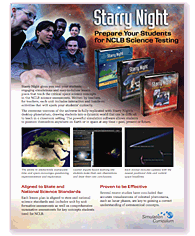
Starry Night® gives you and your students engaging stimulations and easy-to-follow lesson plans that teach the critical space science concepts in the NCLB science assessments.
Written by teachers, for teachers, each unit includes interactive and hands-on activities that will spark your students' curiosity.
Click here to download full brochure.
|
 |
 |
 |
 |
 |
 |
 |
NSTA Area Conference
October 28-30, 2010: Kansas City, MS
CAST (Science Teachers' Association of Texas) Conference
November 10-13, 2010: Houston, TX
Science Teachers' Association of Ontario (STAO) Conference
November 11-13, 2010: Toronto, ON
NSTA Area Conference
November 11-13, 2010: Baltimore, MD
NSTA Area Conference
December 2-4, 2010: Nashville, TN
Details...
|
 |
 |
 |
 |
 |
 |
 |
Educational Inquiries and Sales
Please contact Michael Goodman for all education inquiries. EDUCATION ORDERS 1-877-290-8256
|
 |
 |
 |
 |
 |
 |
 |
Send us your feedback
Do you have a question, comment, suggestion or article idea to pass along to Starry Night® Times?
Click here to get in touch with us.
|
 |
 |
 |
 |
 |
 |
 |
Starry Night® is the world's leading line of educational astronomy software and DVDs. Visit store.starrynight.com to see all the great products we offer for everyone from novice to experienced astronomers.
You have received this e-mail as a trial user of Starry Night® Digital Download or as a registrant at starrynight.com.
To subscribe sign up here.
Starry Night® is a division of Simulation Curriculum Corp.
Simulation Curriculum Corp.
Starry Night® Education
11900 Wayzata Blvd.
Suite 126
Minnetonka, MN 55305
Tel:
1-866-688-4175
|
 |
 |
|










